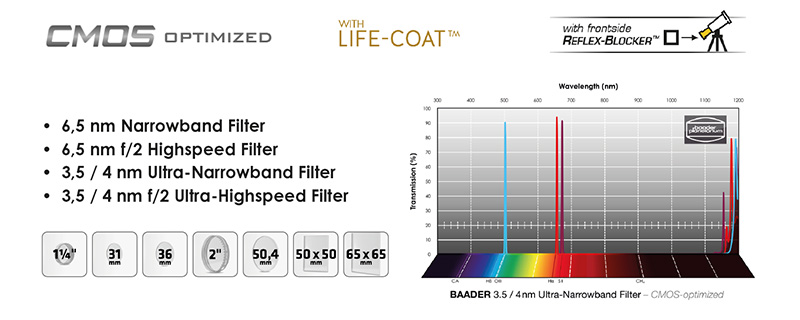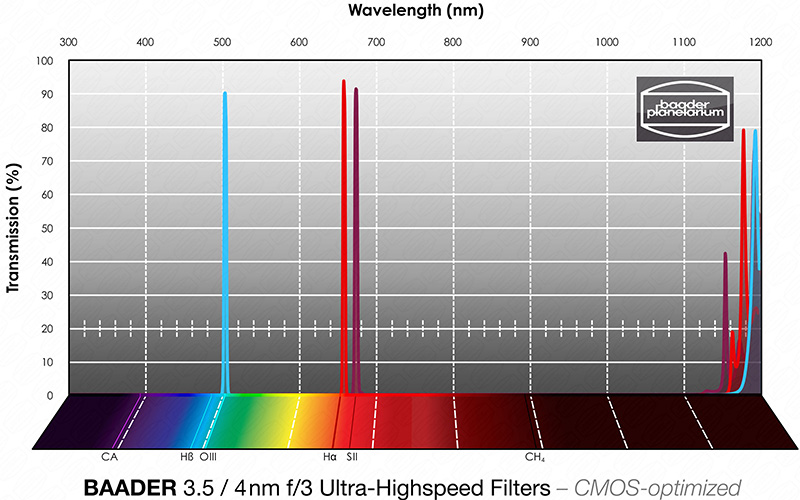About this product
Model: baader_2961525
Part Number: 2961525
Introducing the new CMOS Optimised High Speed F2 Ultra Narrow Band SII Filter from Baader Planetarium.
The new generation of Baader CMOS optimised filters feature
- Increased contrast
- Ever more narrow passbands
- Reflex-Blocker™ coatings, for largest ever freedom from halos, even under most adverse conditions concerning aux-optics
- FWHM on each filter category carefully designed to allow for 1:1:1 exposures, matched for typical CMOS quantum efficiency and s/n ratio
- Identical filter thickness to existing standards, with utmost care for parfocality
- Blackened edges all around, with filter-lead-side-indicator in the form of a black frontside outer rim, to additionally eliminate any reflection due to light falling onto the edge of a filter
- Each filter coated individually, with sealed coating edge (NOT cut out of a larger plate with coatings left exposed)
- Life-Coat™: evermore hard coatings to enable a non-ageing coating for life – even in a most adverse environment
- 3.5 / 4 nm FWHM (to harmonise the exposure time from H-alpha with O-III / S-II), recommended for optical systems faster then F2.3
- Optimised for modern CMOS cameras, but likewise excellent for CCD camera technologies
- For highest contrast even at strongest light pollution, minimises star size, emphasises finest nebula detail – indispensable under Bortle 9/8/7/(6) skies
Please read the Baader Blog concerning Ultra Narrow Band Filters and Pre Shift
Available in all the common filter sizes the new 3.5/4nm High Speed Ultra Narrow Band Filter Sets feature Baaders Life-Coat™: Limited-Lifetime-Warranty
A Baader Planetarium exclusive. Filters incorporating Baader Planetarium’s Life-Coat™ technology are so durable that Baader Planetarium warrants the coatings for the life of the filter. Baader Planetarium has developed Life-Coat™ using materials and processes that result in coatings which will not degrade or fail for a lifetime. Life-Coat™ coatings resist moisture, temperature extremes, and are hardened to withstand normal cleanings.
Baader Planetarium guarantees their Life-Coat™ coatings will not peel, flake or physically degrade and will withstand repeated cleaning with fine optical cleaning equipment. The Limited Lifetime Warranty applies to the original purchaser and does not cover failure from mis-use, physical damage through improper handling, or improper cleaning.
To make a warranty claim, simply contact your retailer where you purchased the filter with proof of purchase (commercial invoice) and a detailed failure description. The dealer will then advise of the next steps.


Preshift and further Information Concerning Baader CMOS Optimised Narrow Band Filters
During the last couple of months after introducing their new CMOS-optimised filter families, Baader have received lots of positive feedback from customers.
However, there was an increasing number of reports and discussions concerning low signal, halo strength and so on, which increasingly showed that the complexity of this topic needs further detailed explanation.
In particular when going to the physical limits, as is the case with Baaders Ultra-Narrowband (UNB) filters, there is no standard solution for every user with different telescopes, sky and weather conditions
This situation was intensified because the f/2 Ultra-Highspeed filter category especially needs a more selective categorisation, in order to select filters with the correct PRESHIFT, to comply with the f/ratio and the amount of obstruction of the respective telescope optics.
Until some weeks ago most customers received filters which worked very well for them, while some others received the same filters –that worked poorly on their scope. It took Baader some time to prepare the necessary insight and knowledge base on how to select filters matched for the many different f/ratios, as well as the different levels of secondary obstruction specifically in the case of Catadioptrics and Newtonians.
Pre Shift - What Is It?
When working with f/2 (to a lesser degree also with f/3 and longer focal lengths), the incoming angles of light will cross any filter with an inclination from 0° to a maximum of 14° with f/2 telescope optics. This requires the bandpass of High speed-dedicated Narrowband filters to be red-shifted by 1 nm to 2,5 nm, depending on the optical parameters of the telescope. Most filter suppliers simply do not preshift their filters peak wavelength at all and customers always receive a filter that is produced "straight on band". This will work well for most telescopes as long as the filter FWHM stays wide and the f/ratio stays well above f/3.4 and only if the telescope optics have zero central-obstruction. But downwards of < f/4 and in conjunction with increasing obstruction of faster optical telescopes, nothing is "on band" anymore, since the transmitted wavefront experiences an ever increasing "blue-shift" – as mentioned, depending on the f/ratio and the amount of obstruction. Without compensating this inevitable blue-shift by a suitable red-preshift, a 95% peak-transmission filter may mutate into a 30% transmission filter. For this reason Baader Planetarium always differentiated between regular narrowbands without preshift and highspeed filters featuring a preshift, in order to provide maximum filter transmission for the wide range of telescope f/ratios.
So far filter manufacturers have not offered any information on the necessity of preshifting narrowband filters at all (very few do offer preshifted filters "on special demand" – at high cost). From a manufacturers perspective this might be somewhat understandable as it requires stocking a multitude of different filter sizes and different filter families for different telescope optics, each filter category redshifted differently by a closely defined degree. And in order to make things even more difficult, even temperature shift needs to be considered to a minor degree. For example, under actual imaging conditions on a winter night at - 20°C, the same filter will have a slightly different shifted transmission window than when used in the lab at +20°C. This will remain insignificant for long focal length optics but becomes increasingly relevant with faster optics.
The Problem Identified
Usually for O III (and S II) a signal strength similar to H-alpha is expected/hoped for, but this is limited by physics. Equalising the signal strength of narrowband O III / S II data to those gained at H-alpha always requires longer or more exposures than in H-alpha, owing to much less energy supplied by O III and S II nebula emission lines. Hard stretching of insufficient depth of data will certainly bring out halos. It is the main reason why there is seldom any halo complaint for H-alpha-filters, compared to O III and S II filters. This fact led Baader to not listen closely enough when feedback occurred concerning insufficient signal – mostly concerning the Highspeed-Version of Ultra-Narrowband filters used at fast optics.
Customer reviews
FAQ
Please fill in the form below to ask a question.